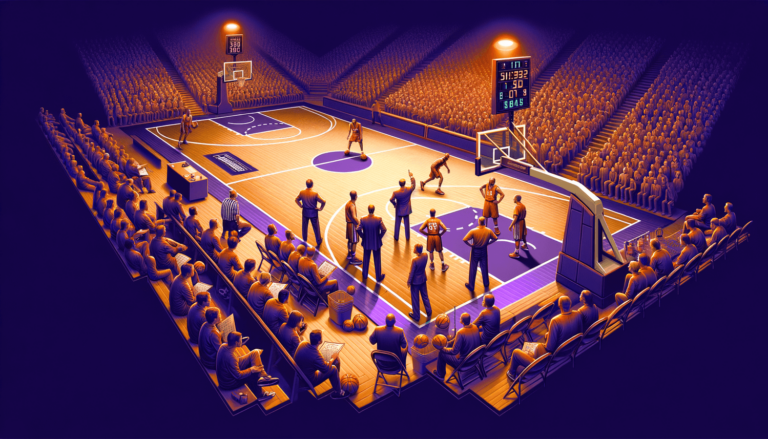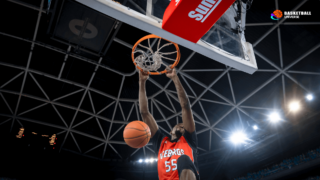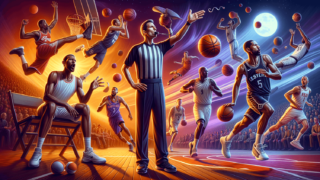
Have you ever watched a basketball game and wondered why the coach suddenly stopped the action, gathered the team, and had an intense huddle in the heat of the game? Well, that’s called a timeout! In this blog post, we’re going to delve into the world of timeouts, from their basic definition to the strategy behind them. Your curiosity won’t be left hanging like a game-winning buzzer-beater! Whether you’re a seasoned fan or a basketball novice, you’ll be ready to impress your friends with your newfound knowledge on this exciting topic.
What Is a Timeout in Basketball?
A timeout in basketball is a break in the game requested by a coach or player, allowing teams to regroup, strategize, and rest. It temporarily stops the game’s clock, gives players an opportunity to hydrate, and provides coaches a chance to discuss tactics with their players. Timeouts are essential to basketball strategy, as they help teams make necessary adjustments on the fly and can often influence the outcome of the game.
Types of Timeouts in Basketball
Timeouts in basketball can be classified into a few different categories, each with their own unique reasons, duration, and impact on the game. Let’s dive deep into the various types of timeouts you’re likely to encounter during a basketball game.
Full Timeouts
As the name suggests, a full timeout lasts longer and provides ample time for both the teams and coaches to regroup and discuss their strategies effectively. In the NBA, a full timeout is 2 minutes and 45 seconds long. Each team is given a set number of full timeouts per game (normally six), although this number can vary slightly depending on overtime and the league’s rules. During a full timeout, coaches can make substitutions, review their game plan, and deliver instructions to help improve their team’s performance on the court.
20-Second Timeouts
In contrast to full timeouts, 20-second timeouts are designed to be quicker and more focused. They allow a team to address any specific, short-term issues such as a single play they want to run or an immediate adjustment. Due to their short duration, these timeouts are best used when a team needs to quickly regroup or build momentum during certain phases of the game. However, keep in mind that the 20-second timeout was replaced by the 30-second timeout in the NBA starting from the 2015-2016 season.
30-Second Timeouts
As mentioned earlier, the NBA introduced the 30-second timeout to replace the 20-second timeout. They are a quick way for teams to make adjustments, primarily in response to specific game situations or to allow players a brief rest. Each team has two 30-second timeouts per game, but unlike full timeouts, these cannot be carried over to the next half or into overtime.
Media Timeouts
These timeouts aren’t called by a coach or a player, but they are integral parts of the game set aside for commercial breaks. In the NBA, media timeouts (also called official timeouts) occur at the first dead ball after the 6-minute and 3-minute marks of each quarter. Media timeouts are useful for both the teams and broadcasters, as they provide opportunities for teams to regroup without using their own timeouts and offer broadcasters precious ad spaces.
When to Use Timeouts in Basketball
Now that you’re familiar with the types of timeouts, it’s essential to understand the strategic reasons behind their usage. Timing is critical when calling timeouts, so let’s delve into some scenarios where a timeout can change the course of a basketball game.
Stop Opposition Momentum
One of the most common reasons to call a timeout is to halt the momentum of the opposing team. In basketball, teams can go on scoring runs and quickly pile on points, potentially turning the tide of the game. Calling a timeout allows the team on the receiving end of such an offensive onslaught to regroup, discuss potential adjustments, and disrupt their opponents’ rhythm.
Rest Players
Basketball can be an incredibly physically demanding sport, with players’ endurance and conditioning often determining the game’s victor. Calling a timeout gives the players a few moments to rest, catch their breath, and rehydrate. Sometimes, sparing their legs from fatigue can help players keep up with the fast-paced action and make better decisions during crucial moments in the game.
Set Up a Specific Play
When the game is on the line, a well-executed play can make all the difference between victory and defeat. Coaches often use timeouts to sketch out plays and convey their instructions one last time before their players take the court. By calling a timeout, a coach can ensure their team is on the same page and well-prepared to execute the play.
Prevent a Turnover or Violation
Another strategic use of a timeout is to avoid potential on-court mishaps, such as a player losing control of the ball, failing to inbound the ball within the allotted time, or nearly resulting in a 5-second violation. In such instances, a player or coach can call a timeout to rectify the situation, which has the added benefit of potentially retaining possession instead of conceding it to the opposition.
Timeout procedure and rules
To make the most of a timeout, it is crucial to understand when and how they can be called as well as how they are regulated across different basketball leagues. Here, we’ll break down the process of calling a timeout and examine some of the key rules in various leagues.
Timeout Regulations in the NBA
In the NBA, there are specific rules in place to manage timeouts. Each team is allocated six full timeouts during regulation play and two timeouts during overtime. Teams can only carry over a maximum of four full timeouts from the first half to the second half, meaning any remaining timeouts are lost. Additionally, each team has two 30-second timeouts per game. If a game goes into overtime, teams get an additional 2-minute timeout for each overtime period. It is important to note that these rules may change at the discretion of the NBA and vary between leagues.
How to Call a Timeout
Both players on the court and coaches can call a timeout, but it is necessary to first secure the basketball. A timeout can be requested during a dead ball situation (e.g., after a basket is scored) or while the player in possession maintains control of the ball. To signal for a timeout, a player or coach should make a “T” shape with their hands and notify the nearest official.
Timeout Substitutions
During a timeout, coaches can make substitutions as necessary. Players entering the game must first check in at the scorer’s table, and the official scorer will notify the referees of any substitutions. Once a timeout is over, referees will ensure the substituted players enter the court before resuming play.
Timeouts in College Basketball
The rules surrounding timeouts in college basketball are slightly different from those in the NBA. In NCAA basketball, teams are granted a greater number of timeouts, with varying lengths, and are awarded based on different criteria. Let’s examine the key differences in college basketball.
Film Study
One of the major differences between college and professional basketball is the focus on film study. College coaches often use timeouts to review specific plays and apply the insights gained from understanding opponents’ tendencies. This extra layer of preparation and planning can add a new dimension to the game’s strategy, making timeouts even more valuable in high-level college basketball contests.
NCAA Timeout Regulations
In NCAA Division I men’s basketball, teams are given four 30-second timeouts, three 60-second timeouts, and one 60-second timeout for added overtime periods. Each team can carry over a maximum of three 30-second timeouts and all 60-second timeouts to the second half. In NCAA Division I women’s basketball, teams are given four 75-second timeouts, and two additional timeouts are awarded for the first and second overtime periods. Unused timeouts from regulation do not carry over into overtime.
Streamlined Coaching
College basketball coaches usually have more one-on-one time with the athletes, which allows them to focus on individual development and relationships. As such, timeouts in college games tend to prioritize coaching and teaching moments. Whether it’s reinforcing proper defensive technique, adjusting offensive tactics, or providing real-time feedback on a player’s performance, coaches utilize timeouts to help young athletes develop both on and off the court.
Timeout Strategy and Results
A successful basketball team is like a finely tuned machine, where every tiny cog has a vital role to play. The way timeouts are managed can have lasting effects on individual games and, in turn, a team’s entire season. So, let’s briefly examine how critical aspects of timeout strategy can impact the game.
Managing Fatigue
Athletes’ performance can be significantly influenced by their level of fatigue. Fitness levels, hydration, and accumulated minutes on the court all play a role in determining how quickly fatigue sets in. A coach must be aware of these factors and manage their timeouts accordingly, offering relief to players in moments when their bodies demand it the most.
Identifying Matchups
Timeouts can be instrumental in finding favorable matchups on the court. Expert coaches tactfully use timeouts to discuss and exploit their opponents’ weaknesses or suboptimal lineups. By reviewing match footage and statistics, coaches can better identify which opponents are struggling defensively or offensively, and they can then create strategies to take advantage.
Controlling Tempo
Basketball is a game of constant tempo shifts, with some teams thriving under fast-paced conditions while others prefer a slower, methodical approach. Timeouts offer coaches the opportunity to dictate the game’s tempo and rhythm, ensuring their players are performing optimally within their preferred game style.
From the basics of timing, types, and regulations to advanced timeout strategies, this exploration of timeouts in basketball equips you with everything you need to better appreciate the game with both friends and fellow sports enthusiasts. Navigate actual games with ease the next time you witness a timeout
International Basketball Timeout Rules
Now that we have explored the timeout rules in the NBA and college basketball, it’s time to examine the rules governing timeouts in international basketball. The international governing body for basketball, FIBA, has some unique regulations that dictate the usage of timeouts, further influencing game strategy globally.
FIBA Timeout Regulations
In FIBA-sanctioned games, each team is granted two timeouts during the first half, three timeouts during the second half, and one timeout for every overtime period. Unlike other leagues, coaches can only call timeouts in FIBA games, where they request a timeout verbally or by pressing the buzzer at the scorer’s table. This rule emphasizes the importance of coaching expertise and decision-making during games, as players do not have the option to call timeouts themselves.
Exclusive Use during Dead Ball Situations
For FIBA games, all timeouts must be taken during dead ball situations, such as when the ball goes out of bounds, a team scores a basket, or when there is a stoppage called by the referees. This rule prevents teams from calling timeouts while they have possession of the ball, effectively reducing the chances of using timeouts as a bailout to prevent a turnover or other unfavorable situation.
How Timeouts Affect Game Flow
Now that we’ve explored various rules and regulations of timeouts in basketball, let’s consider the impact timeouts have on the game’s flow and viewer experience.
Effect on Game Pace and Duration
Each basketball game is made up of several timeouts, turning the scheduled 48 minutes of playing time into a significantly longer experience. In an NBA game, those 48 minutes can sometimes stretch into a 2 to 2.5-hour event. Timeouts, along with other stoppages due to personal fouls and out-of-bound plays, contribute to the elongated duration of games, affecting the overall pace of the game.
Managing Fan Experience
Too many timeouts can also lead to a less engaging fan experience. As the game’s excitement is periodically interrupted, the constant breaks may lessen the enthusiasm of viewers. To combat this issue, leagues like the NBA have implemented changes to timeout rules over time, seeking to strike the right balance between strategic moments and uninterrupted gameplay. Such continual improvements aim to build upon the foundation of basketball’s action-packed and captivating nature.
Timeouts in Wheelchair Basketball
Basketball is not just limited to the traditional game that is widely known. Wheelchair basketball has its own unique rules and guidelines that include timeout regulations. These adapted rules are tailored to wheelchair basketball players, ensuring that the sport’s excitement and strategy are maintained, providing an inclusive perspective to basketball as a whole.
Wheelchair Basketball Timeout Rules
In wheelchair basketball, which follows the International Wheelchair Basketball Federation (IWBF) rules, each team is granted two timeouts in the first half, three timeouts in the second half, and one timeout for every overtime period. Timeouts in wheelchair basketball are 60 seconds long, providing the athletes adequate time to rest and regroup. With a focus on inclusivity and fair competition, these rules demonstrate the difficulties and nuances unique to wheelchair basketball compared to the traditional game.
This comprehensive exploration of timeouts in basketball gives you a well-rounded understanding from the NBA to FIBA, college, and even wheelchair basketball. Now, you can confidently share your knowledge with fellow fans and sports enthusiasts, solidifying your reputation as a true basketball expert.
Frequently Asked Questions
In this FAQ section, we’ve compiled a list of commonly asked questions related to timeouts in basketball, answering them concisely to help deepen your understanding of this intriguing element of the sport. These questions touch upon various aspects of timeouts, providing insights that will surely satisfy your curiosity and broaden your knowledge.
1. Can a player call a timeout in college basketball?
Yes, both players on the court and coaches can call a timeout in college basketball. However, the player must have possession of the ball or during a dead ball situation to request a timeout.
2. Can a player call a timeout in FIBA basketball?
No, only coaches can call timeouts in FIBA basketball games. To request a timeout, coaches communicate verbally or press the buzzer at the scorer’s table during dead ball situations.
3. How do NBA teams signal for timeouts?
Coaches and players can signal for a timeout by forming a “T” shape with their hands and notifying the nearest referee during dead ball situations or when their team has control of the ball.
4. Can a team gain more timeouts during a game?
Teams cannot gain additional timeouts beyond the allotted amount per game. However, teams are granted one extra timeout for each overtime period.
5. Can a team lose timeouts during a game?
Yes, teams can lose timeouts. In some leagues, such as the NBA, teams can lose any unused timeouts if they are not carried over to the next half or overtime period.
6. When is the best time to use a 20-second or 30-second timeout?
Shorter timeouts, like the 20-second or 30-second timeouts, are best used as a quick regrouping tool during specific game situations or when players need a brief rest. They are also helpful when coaches want to make minor adjustments to their team’s tactics or address a specific in-game problem.
7. How does overtime affect timeouts in the NBA?
In the NBA, each team is given an additional two-minute timeout for every overtime period. This extra timeout helps teams with rest and strategic adjustments during extended play.
8. Can a coach call a timeout if their team doesn’t have possession of the ball?
No, coaches cannot call a timeout if their team does not have possession of the ball. A timeout can only be called during a dead ball situation or when the team requesting the timeout has control of the ball.
9. Can you call a timeout during a live ball situation?
A timeout can only be called during a live ball situation if the team requesting it has possession of the basketball. Otherwise, a timeout must be called during a dead ball situation, such as after a basket is scored or when the ball goes out of bounds.
10. How many timeouts does each team have in college basketball?
In NCAA Division I men’s basketball, each team has four 30-second timeouts and three 60-second timeouts during regulation play. They also have one 60-second timeout for each added overtime period. Unused timeouts can be carried over to the next half or overtime, subject to certain limitations. In NCAA Division I women’s basketball, teams are given four 75-second timeouts, with additional timeouts for overtime periods.
11. How many timeouts does each team have in wheelchair basketball?
In wheelchair basketball, each team has two 60-second timeouts in the first half, three 60-second timeouts in the second half, and an additional timeout for each overtime period. These timeouts provide adequate opportunities for rest, strategy adjustments, and regrouping during wheelchair basketball games.
12. Can timeouts be used to disrupt the flow of the game?
Yes, one strategic use of timeouts is to disrupt the flow of the game, especially when the opposing team has gained momentum. Timeouts provide an opportunity for teams on the receiving end of an offensive onslaught to regroup, make adjustments, and try to break the opponent’s rhythm.
13. Can teams carry over unused timeouts?
In some basketball leagues, such as the NCAA and NBA, teams can carry over unused timeouts from the first half to the second half or in some cases, overtime periods. However, there are limitations to the number of timeouts that can be carried over, and some types of timeouts cannot be carried over at all.
Featured Posts
- No pillar pages found.





